Home Brugmansia Care Guide for Beginner Florists
Brugmansia belongs to the category of shrubs or trees that delight their owner with chic bell flowers hanging down. For such a phenomenon, the flowers were called angelic trumpets.
An ornamental culture, akin to dope, is planted not only in the open field, but also at home. Caring for brugmansia will not cause much trouble if you follow the basic rules.
Description
Brugmansia is considered an evergreen shrub, native to the subtropics of South America. The plant has received several names due to its characteristics. Florists call the shrub:
- demon tree;
- trumpets of an angel;
- dope;
- tree brugmansy.
Under natural conditions, Datura grows in areas with a humid forest climate. When grown at home, you can plant bushes in open ground in the summer months, and with the onset of the first cold weather, transplant brugmansia into tubs and bring it into the premises.
The height of an ornamental crop growing in natural conditions reaches 480-500 cm. For growing at home, it is advisable to select plant species that are stunted. Oval leaf plates are large enough. Their edges are wavy. The length can reach 45-50 cm. Depending on the variety, foliage can be painted in different shades:
- red;
- green;
- yellow;
- orange;
- cream.
Also, breeders have bred new varieties of brugmansia, the leaf plates of which are painted in 2-3 shades. The aroma of flowers is pronounced. An increase in the smell is observed from 19 to 23 hours.
Note! Decorative culture is endowed by nature with the ability of psychotropic influence. Therefore, if you want to grow a similar plant on your site, it is worth considering in detail the location of the shrub. It is not recommended to expose flowerpots near the sleeping area.
Taking care of brugmansia is easy enough. However, in order for the plant to please with abundant flowering, it should be provided with proper wintering. If there are small children and animals in the house, it is better to abandon the idea of growing dope.
Varieties of brugmansia
Among the most popular varieties of dope, it is worth highlighting:
- Fragrant or scented brugmansy. The birthplace of culture is Brazil. Shrubs grow in areas with hot climatic conditions. If you provide the plant with favorable conditions for indoor growth, you can achieve abundant flowering, which will delight the owner throughout the year. The height of the shrub can reach 400-500 cm, however, with the help of pruning, the growth of a tree culture can be regulated. Flowers of the variety are painted in white or light green tones. Their diameter reaches 15 cm, and their length does not exceed 30 cm.
- Golden brugmansia, characterized by the presence of yellow-orange flowers. The length of the leaf plates can reach 45-50 cm. The golden variety is unpretentious.
- Snow-white brugmansia, which is often used to breed new hybrids. The height of a tree-like shrub can reach 250-300 cm. During flowering, the plant takes on an amazing appearance. Flowers, the length of which reaches 25 cm, are painted in snow-white shades.
- Bloody dope, named after the bright red and orange flowers that appear on bushes during flowering. Ornamental culture belongs to the category of frost-resistant plants. The amazing scent emanating from the flowers quickly spreads throughout the area.
- Multi-colored brugmansia is a type of Datura, which is distinguished by its extraordinary flowering. In the early years, the flowers of the plant are painted in a white palette. Over time, their color changes to peach or orange tones. The height of this type of shrub does not exceed 400 cm.The length of the flowers reaches 50 cm.
Is it possible to grow at home
In our country, brugmansia is grown as an exotic indoor or greenhouse decorative culture, which bewitches the eye with drooping flowers, endowed with large size by nature.
When keeping the culture indoors, foliage will not fall off. It is very important, when caring for a shrub, to adhere to the recommendations of specialists. This will allow you to grow healthy bushes that will delight you with abundant flowering every year.
Optimal conditions of detention
Below is information regarding the recommended conditions for keeping Datura.
Lighting
Brugmansia prefers areas that are well lit by sunlight. Datura can be planted outdoors during the summer months. At this time of the year, the sun's rays are enough for the shrubs, but in winter, when the culture is transplanted into tubs and brought into the house, it is recommended to carry out additional lighting. For this purpose, you can use special phytolamps. In the cold season, it is important to extend the daylight hours to 15-16 hours.
Temperature regime
The decorative culture does not particularly like heat, but it can endure it steadily. But severe cold can destroy the plant. It is very important not to let the temperature drop below 5 degrees Celsius. The recommended temperature in the room in which the brugmansia tubs are exposed should reach 23-24 degrees.
Humidity
Additionally, there is no need to spray dope bushes. However, in a prolonged sultry period, this method of moistening can also be used to save the bushes from death.
How to care for a flower at home
In order for the plant to please with abundant flowering, it is important to properly care for it. Below you can find recommendations for plant care.
Watering
In the warm season, brugmansia needs frequent and abundant watering. Large sheet plates have the ability to quickly evaporate moisture. As soon as the flowering period begins, growth stops. During this period, the frequency of soil moistening can be reduced. During the winter months, the soil is moistened as the topsoil dries out.
Top dressing
At the moments of active growth of the shrub and during the flowering period, brugmansia needs systematic feeding. For this purpose, balanced mineral dressings, which are intended for flowering indoor plants, are perfect. You can also use organic.
Pruning
Regulatory pruning should be done annually in the summer months. To do this, the florist must remove the wilting flowers and some of the stepsons. Excessive density of bushes provokes a decrease in the size of flowers and leaf plates.
At the end of November, when the flowering period is over, the length of the shoots is shortened. Cut branches can be used for propagation by cuttings.
Features of care during flowering
Flowering period brugmansii lasts from mid-summer to early winter. Flowers wither quickly, but their rapid blooming one after another can give the impression of continuous flowering. After wilting, the flowers fall off. As soon as the budding period is over, the peduncles can be removed.
Note! The amazing aroma that comes from a blooming ornamental culture can provoke severe headaches and vomiting, which develops against a background of severe cramps. It is unacceptable to put pots with bushes near the sleeping area and in places where children spend time and pets are.
Features of care at rest
Closer to December, the dope goes into a state of rest. Bushes during this period should remain in a bright and cool room. The room temperature can reach 7-11 degrees. The amount of soil moisture is minimized. Top dressing is not applied. At this time, the bushes can shed their foliage, but most often this does not happen when grown at home.
As soon as the spring days will please you with warmth, you can periodically take the bushes out into the fresh air, gradually accustoming them to walking.
Protection against diseases and pests
Brugmansia is not susceptible to disease, however, improper care of the shrub often provokes the occurrence of rot. As a rule, the disease can be provoked by:
- excessive soil density;
- lack of a drainage system;
- frequent waterlogging of the earth.
Also, rot can occur against the background of a fungus. In order to cope with the problem, you will need:
- Remove the bushes from the tub.
- Prune rotten roots.
- Treat the ornamental culture with a fungicidal agent.
- Plant the bush in a pot filled with new potting soil.
Despite the fact that brugmansia is toxic, pests often harm decorative culture.
Table 1. Ways of pest control.
|
Insects |
Symptoms |
Ways to fight |
|
Weevil |
On the extreme areas of the sheet plates, gouged zones appear. The buds that have not yet had time to open fall off. |
Every 7 days, insecticidal treatment should be carried out until the weevils completely disappear. |
|
Whitefly |
Yellowing of the leaf plates and their further subsidence. Sluggish appearance of foliage and flowers. |
Experts recommend using special insect traps and spraying with insecticidal agents. |
|
Spider mites |
The appearance of light points on sheet plates. Cobweb formation on the back of the leaf plates. |
It is important to spray with Aktara as soon as possible. |
|
Snails and slugs |
Hole formation on green mass. |
Experts recommend spraying with insecticidal agents like Actellik and Iskra. |
Reproduction
There are several ways to breed brugmansia. Below you can familiarize yourself with each of them in detail.
Cuttings
Reproduction by cuttings is carried out in the spring or autumn. To this end, you will need:
- Start harvesting cuttings. To do this, it is necessary to cut the upper parts of the young lignified shoots. It is very important that each shoot has a growing point and several buds.
- Leaf plates are cut from the cut cuttings.
- A pair of activated carbon tablets is poured into a container filled with water.
- The shoots are dipped into the liquid. The capacity is transferred to a room well-lit by the sun's rays. The room temperature should be between 20-22˚С.
- After a few weeks, a root system will begin to appear on the cuttings. A few weeks after root emergence, the shoots are planted in moist, loose soil. For planting, it is recommended to use a soil mixture consisting of sand, black soil, perlite and peat.
Seed method
Seed propagation is a very slow process. It should also be borne in mind that varietal characteristics with this method of reproduction can be lost.
Step by step process:
- Sowing seeds is recommended in February. Before planting, the seeds are soaked for 24 hours in a growth stimulator.
- A deep container is filled with soil with a neutral acidity level.
- Seeds are laid out on the surface of the soil.
- A small layer of earth is crushed on top.
- The container is covered with a piece of glass and transferred to a well-lit room, where the temperature reaches 25˚С.
- The ground is systematically moistened, and the glass is removed for ventilation.
- Seedlings should be expected 4-6 weeks after planting.
- After the seedlings have appeared on the surface of the soil, the glass is removed. Seedlings are sprayed with warm water.
- As soon as the 5-leaf plate begins to form on the seedlings, the seedlings can be split into separate containers.
Reproduction by layering
For the propagation of an ornamental culture, it is necessary to pick up undersized bushes. The procedure is carried out at the end of spring.
- In the upper area of the bushes, healthy shoots are selected, the diameter of which is in the range of 20-22 cm. On each shoot, a Y-shaped incision is made, which is sprinkled with a small amount of a growth stimulator.
- Wet moss is applied in a circle of incisions, after which the branches can be wrapped with a layer of polyethylene and fixed with an elastic band.
- For 30 days, using a medical syringe, measures should be taken to moisten the moss.
- After the roots begin to appear, the shoots can be cut off. The sheet plates on the layers are removed. The moss is removed and the layers are planted in the selected area.
In order for the plants to take root quickly, it is recommended to spray them daily.
Transfer
In order for the plant to grow healthy, it is necessary to use nutritious light earth for planting, which includes:
- low-lying peat;
- humus;
- garden land.
If desired, a small amount of sand, perlite and vermiculite can be added to the soil. By mixing charcoal with the soil, most fungal diseases can be avoided.
A large container for planting is chosen, since the shrub is rapidly gaining growth. The transplant is carried out in early spring, while the main points of growth have not yet had time to awaken. Small bushes are transplanted by transferring to a larger pot. In an adult dope, the top layer of the earth changes.
Before starting planting, a small part of expanded clay, charcoal and pebbles should be poured onto the surface of the bottom of the container. After that, a small part of the soil mixture is poured, and the rooted cutting is transferred to the pot along with the old clod of earth. The resulting voids are filled with nutrient soil. The earth is compacted and moistened.
Note! If necessary, during transplantation, you can slightly cut the roots of the plant, removing dying or decaying parts.
Common Care Mistakes to Avoid
Flower growers deprived of experience often make mistakes in caring for bushes, which can lead to the death of dope. Below is information about the most common errors.
Table 2. Correction of errors in care.
|
External manifestation |
The reasons |
Giving help |
|
Falling sheet plates. |
It occurs against the background of a lack of moisture. |
It is important to observe the recommended soil moisture regime. |
|
Pulling out shoots, blanching of leaf plates. |
Bad light. |
It is recommended to arrange additional lighting with phytolamps. |
|
Slowing down the growth rate. |
Lack of nutrition. |
Timely feeding will save the situation. |
|
Falling buds. |
Moisture deficiency. |
Carry out the regulation of the irrigation regime. |
Growing brugmansia at home is quite simple. Bushes can be formed by pruning, which makes it possible to place them even in small apartments. Providing the necessary conditions for growth will allow you to soon enjoy abundant flowering.
Related videos:




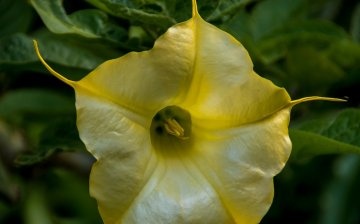
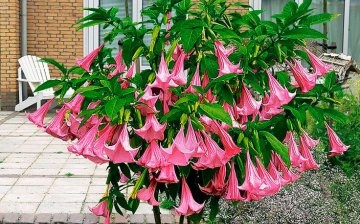



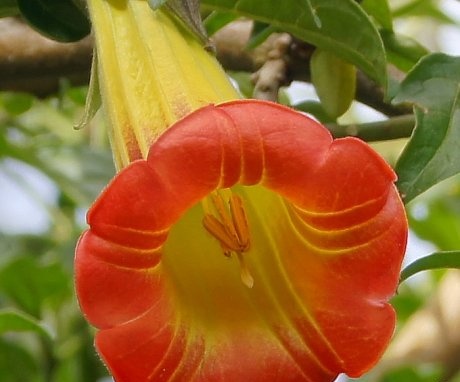
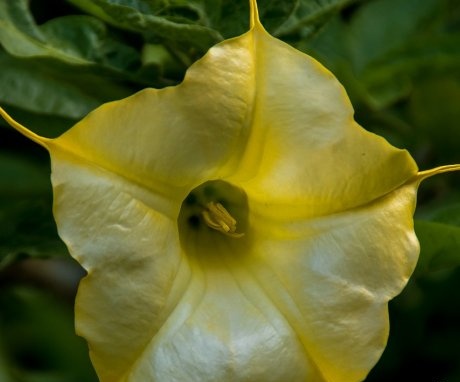
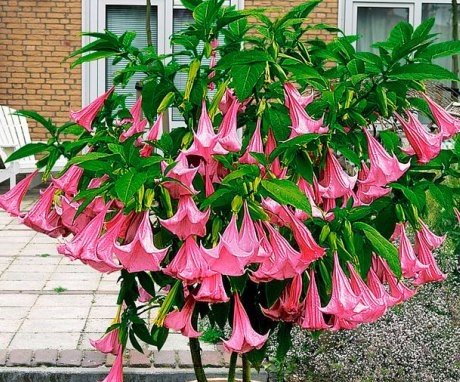
This flower is very beautiful, but it is better to plant it not at home in a pot, but on the street, on a flower bed. In this case, a strong smell, with a psychotropic effect on a person, will not threaten health.
In winter, when the heating system turns on, the air in the lobby becomes rather dry, and we have to take turns, at least twice a day, to spray our two-meter beauty.
In the summer, there is no such need, it is enough to open the window more often and water in a timely manner ...